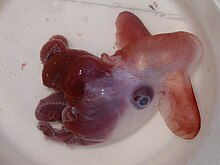Grimpoteuthis
| Grimpoteuthis | |
|---|---|

| |
| Grimpoteuthis discoveryi | |
| Scientific classification | |
| Domain: | Eukaryota |
| Kingdom: | Animalia |
| Phylum: | Mollusca |
| Class: | Cephalopoda |
| Order: | Octopoda |
| Family: | Grimpoteuthidae |
| Genus: | Grimpoteuthis Robson, 1932 |
| Species | |
|
14, see text | |

The octopuses of the genus Grimpoteuthis are also known as Dumbo octopuses from the ear-like fins protruding from the top of their head-like bodies, resembling the ears of Walt Disney's flying elephant. They are bathyal creatures, living at extreme depths of 3000–4000 meters, with some living up to 7000 meters below sea level, which is the deepest of any octopus species to be found. They are some of the rarest of the Octopoda species. They can flush the transparent layer of their skin at will, and are pelagic animals, as with all other cirrate octopuses. The largest Dumbo octopus ever recorded was 6 feet in length and weighed 13 pounds, although the normal size for the various species is thought to be smaller.[1]
They hover above the sea floor, searching for worms, bivalves, pelagic copepods, and other crustaceans for food. The Dumbo octopus is strange in the way it consumes food in that it swallows its prey whole, which differs from any other kind of octopus.[citation needed] They move by pulsing their arms, shooting water through their funnel, by waving their ear-like fins, or any combination thereof. Males and females differ in their size and sucker patterns. Dissected females have yielded eggs during different stages of development, which has led to the conclusion that females lay eggs consistently, with no distinct breeding season.[2] Male Dumbo octopuses possess an enlarged segment on one of their arms, and it is thought that this arm plays a role in the reproduction of the octopuses. The arm transfers a spermatophore into the female during copulation.[3]
Species
- Red Jellyhead, Grimpoteuthis abyssicola
- Grimpoteuthis bathynectes
- Grimpoteuthis boylei
- Grimpoteuthis challengeri
- Grimpoteuthis discoveryi
- Grimpoteuthis hippocrepium
- Small Jellyhead, Grimpoteuthis innominata
- Grimpoteuthis meangensis
- Grimpoteuthis megaptera
- Grimpoteuthis pacifica
- Grimpoteuthis plena
- Grimpoteuthis tuftsi
- Grimpoteuthis umbellata
- Grimpoteuthis wuelkeri - possibly same as G. umbellata or G. plena
Several species formerly placed in this genus were moved to other opisthoteuthid genera.[4]
References
- ^ http://www.nefsc.noaa.gov/press_release/2009/MediaAdv/MA0908/index.html
- ^ http://www.brighthub.com/environment/science-environmental/articles/62036.aspx
- ^ http://web.mac.com/biomescenter/Biomescenter.com_annex/essay:_dumbo_octopus.html
- ^ Collins, Martin A. (2003): The genus Grimpoteuthis (Octopoda: Grimpoteuthidae) in the north-east Atlantic, with descriptions of three new species. Zool. J. Linn. Soc. 139(1): 93–127. doi:10.1046/j.1096-3642.2003.00074.x (HTML abstract)
External links
- Dumbo Octopus at BBC
